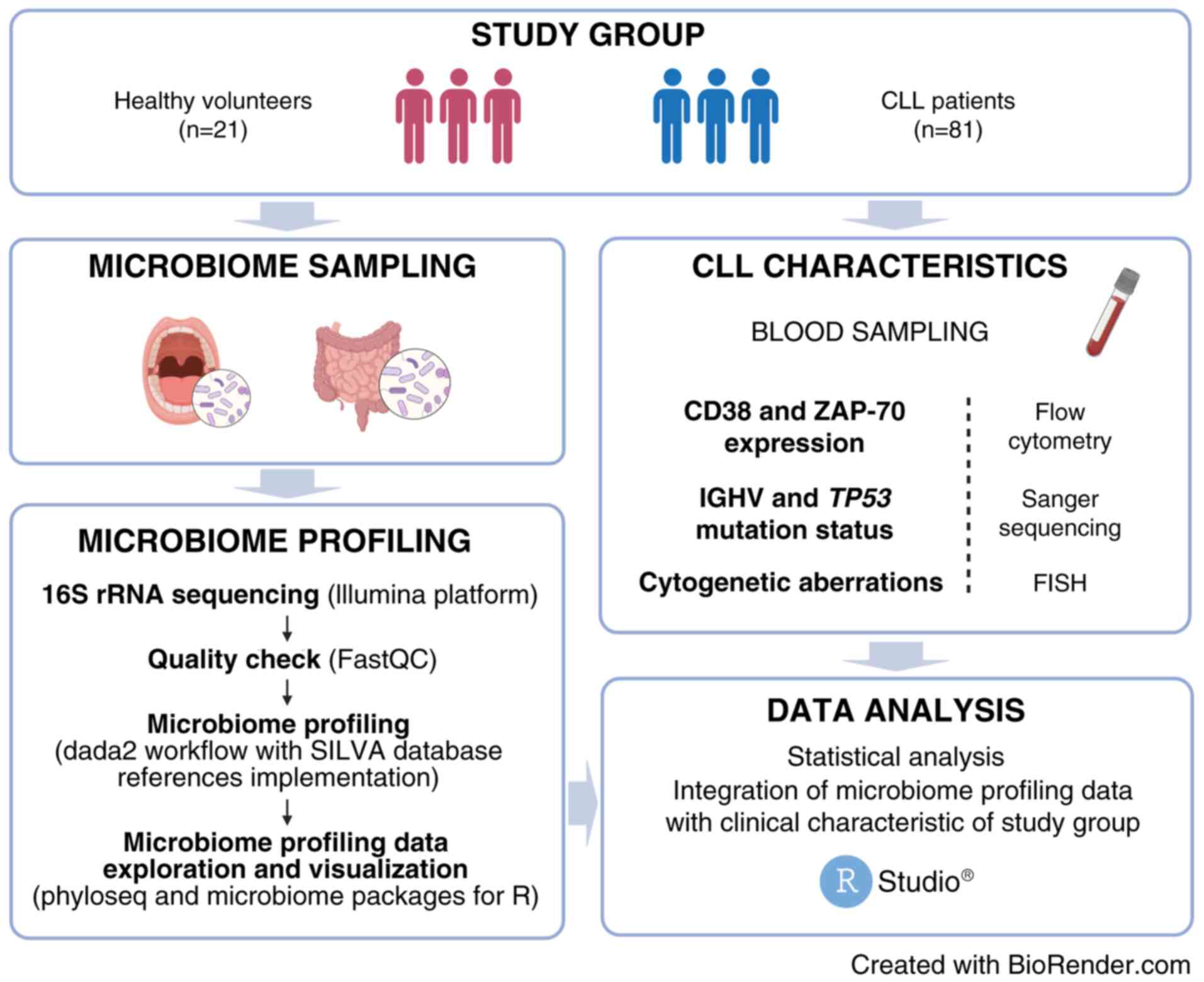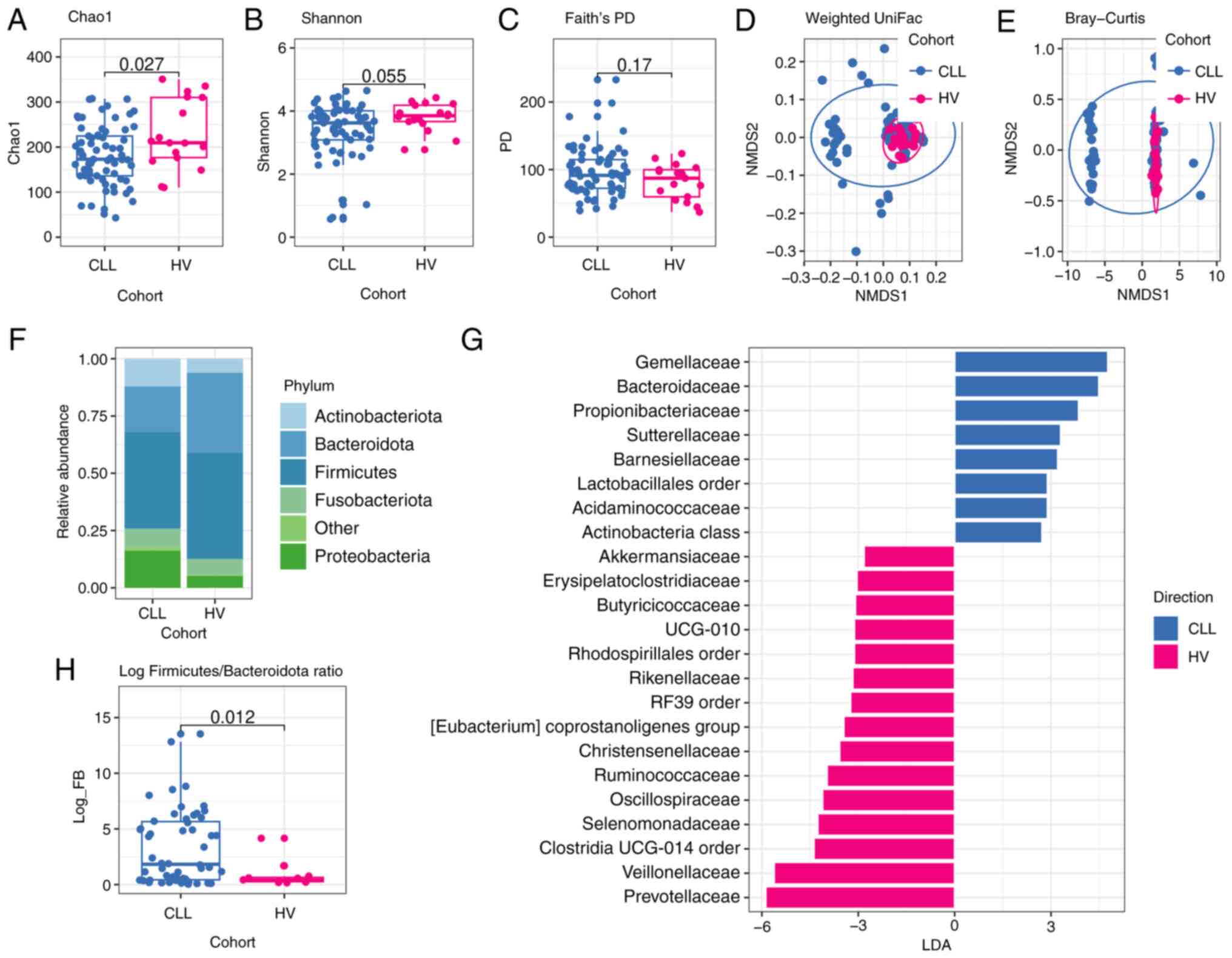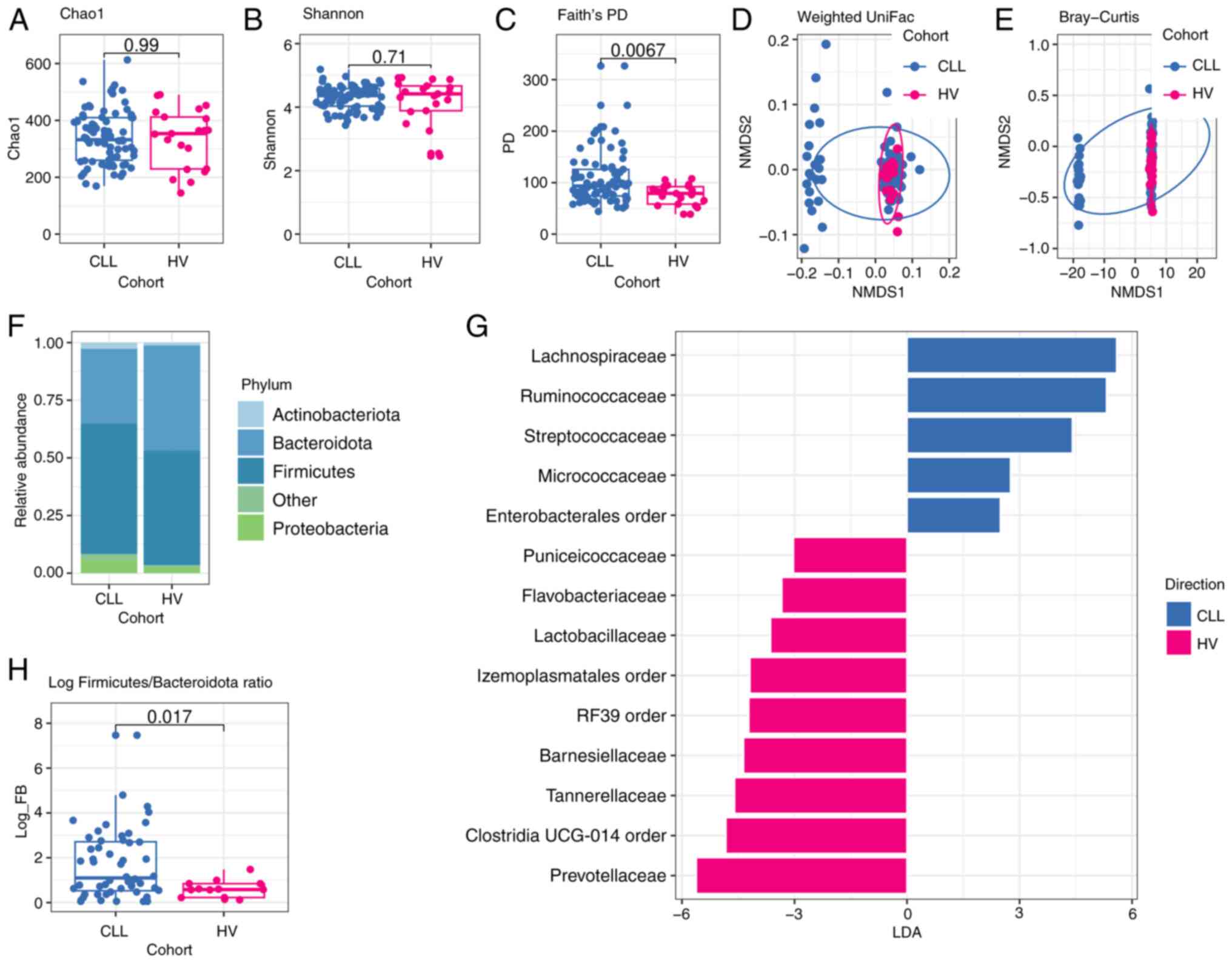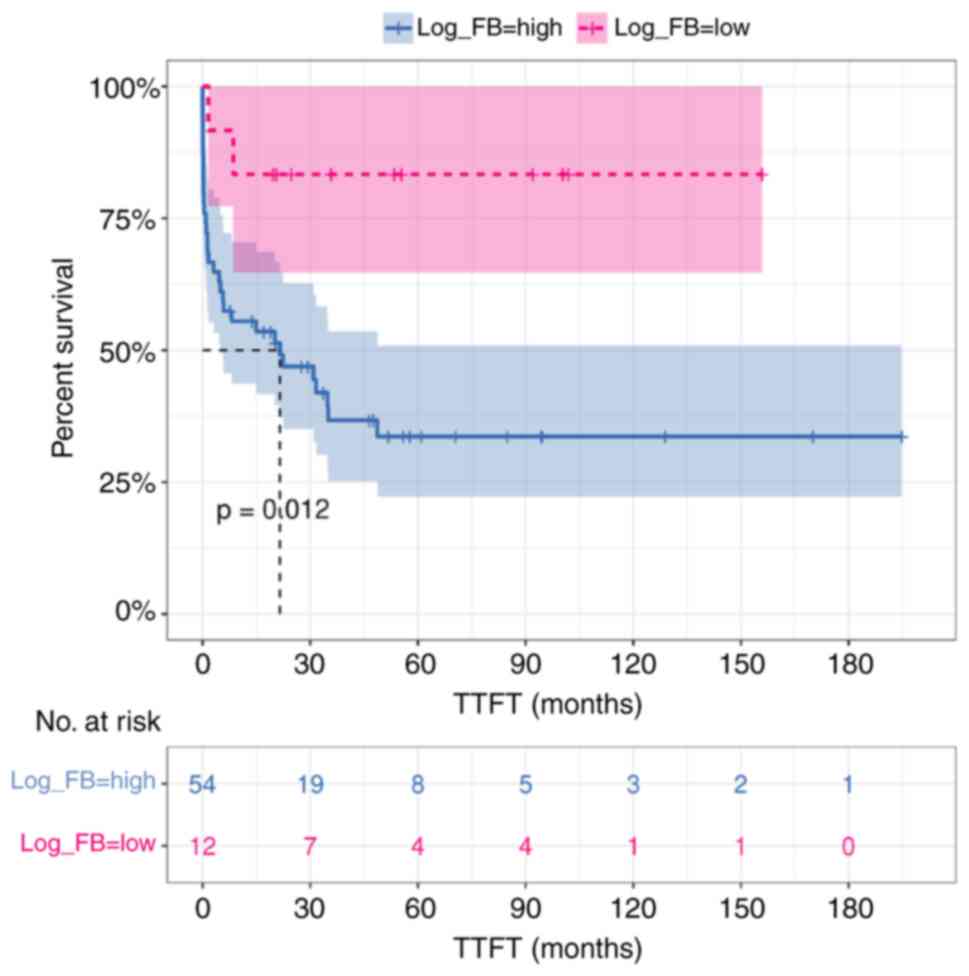Increased abundance of Firmicutes and depletion of Bacteroidota predicts poor outcome in chronic lymphocytic leukemia
- Authors:
- Magdalena Paziewska
- Monika Szelest
- Michał Kiełbus
- Marta Masternak
- Joanna Zaleska
- Ewa Wawrzyniak
- Aleksandra Kotkowska
- Monika Siemieniuk-Ryś
- Marta Morawska
- Elżbieta Kalicińska
- Paula Jabłonowska
- Tomasz Wróbel
- Anna Wolska-Washer
- Jerzy Zdzisław Błoński
- Tadeusz Robak
- Lars Bullinger
- Krzysztof Giannopoulos
-
Affiliations: Department of Experimental Hematooncology, Medical University of Lublin, 20-093 Lublin, Poland, Department of Hematology, Medical University of Lodz, 93-510 Lodz, Poland, Department of Hematology, Blood Neoplasms and Bone Marrow Transplantation, Wroclaw Medical University, 50-367 Wroclaw, Poland, Department of Experimental Hematology, Medical University of Lodz, 93-510 Lodz, Poland, Department of Hematology, Oncology and Cancer Immunology, Charité-Universitätsmedizin Berlin (Corporate Member of Free University of Berlin, Humboldt University of Berlin), D-13353 Berlin, Germany - Published online on: September 17, 2024 https://doi.org/10.3892/ol.2024.14685
- Article Number: 552
-
Copyright : © Paziewska et al. This is an open access article distributed under the terms of Creative Commons Attribution License [CC BY 4.0].
This article is mentioned in:
Abstract
 |
 |
 |
 |
|
Beekman R, Chapaprieta V, Russiñol N, Vilarrasa-Blasi R, Verdaguer-Dot N, Martens JHA, Duran-Ferrer M, Kulis M, Serra F, Javierre BM, et al: The reference epigenome and regulatory chromatin landscape of chronic lymphocytic leukemia. Nat Med. 24:868–880. 2018. View Article : Google Scholar : PubMed/NCBI | |
|
Oakes CC, Seifert M, Assenov Y, Gu L, Przekopowitz M, Ruppert AS, Wang Q, Imbusch CD, Serva A, Koser SD, et al: DNA methylation dynamics during B cell maturation underlie a continuum of disease phenotypes in chronic lymphocytic leukemia. Nat Genet. 48:253–264. 2016. View Article : Google Scholar : PubMed/NCBI | |
|
Ten Hacken E and Burger JA: Microenvironment interactions and B-cell receptor signaling in Chronic Lymphocytic Leukemia: Implications for disease pathogenesis and treatment. Biochim Biophys Acta. 1863:401–413. 2016. View Article : Google Scholar : PubMed/NCBI | |
|
Nadeu F, Clot G, Delgado J, Martín-García D, Baumann T, Salaverria I, Beà S, Pinyol M, Jares P, Navarro A, et al: Clinical impact of the subclonal architecture and mutational complexity in chronic lymphocytic leukemia. Leukemia. 32:645–653. 2018. View Article : Google Scholar : PubMed/NCBI | |
|
Nadeu F, Diaz-Navarro A, Delgado J, Puente XS and Campo E: Genomic and epigenomic alterations in chronic lymphocytic leukemia. Annu Rev Pathol Mech Dis. 15:149–177. 2020. View Article : Google Scholar : PubMed/NCBI | |
|
Baliakas P, Moysiadis T, Hadzidimitriou A, Xochelli A, Jeromin S, Agathangelidis A, Mattsson M, Sutton LA, Minga E, Scarfò L, et al: Tailored approaches grounded on immunogenetic features for refined prognostication in chronic lymphocytic leukemia. Haematologica. 104:360–369. 2019. View Article : Google Scholar : PubMed/NCBI | |
|
Stevenson FK, Forconi F and Kipps TJ: Exploring the pathways to chronic lymphocytic leukemia. Blood. 138:827–835. 2021. View Article : Google Scholar : PubMed/NCBI | |
|
Hilal T, Gea-Banacloche JC and Leis JF: Chronic lymphocytic leukemia and infection risk in the era of targeted therapies: Linking mechanisms with infections. Blood Rev. 32:387–399. 2018. View Article : Google Scholar : PubMed/NCBI | |
|
Benckert J, Schmolka N, Kreschel C, Zoller MJ, Sturm A, Wiedenmann B and Wardemann H: The majority of intestinal IgA+ and IgG+ plasmablasts in the human gut are antigen-specific. J Clin Invest. 121:1946–1955. 2011. View Article : Google Scholar : PubMed/NCBI | |
|
Jain T, Sharma P, Are AC, Vickers SM and Dudeja V: New insights into the cancer-microbiome-immune axis: Decrypting a decade of discoveries. Front Immunol. 12:6220642021. View Article : Google Scholar : PubMed/NCBI | |
|
Zheng D, Liwinski T and Elinav E: Interaction between microbiota and immunity in health and disease. Cell Res. 30:492–506. 2020. View Article : Google Scholar : PubMed/NCBI | |
|
Wlasiuk P, Niedzielski A, Skorka K, Karczmarczyk A, Zaleska J, Zajac M, Putowski M, Pac-Kozuchowska E and Giannopoulos K: Accumulation of CD5+CD19+ B lymphocytes expressing PD-1 and PD-1L in hypertrophied pharyngeal tonsils. Clin Exp Med. 16:503–509. 2016. View Article : Google Scholar : PubMed/NCBI | |
|
Yuan D, Tao Y, Wang H, Wang J, Cao Y, Cao W, Pan S and Yu Z: A comprehensive analysis of the microbiota composition and host driver gene mutations in colorectal cancer. Invest New Drugs. 40:884–894. 2022. View Article : Google Scholar : PubMed/NCBI | |
|
Lazar V, Ditu LM, Pircalabioru GG, Gheorghe I, Curutiu C, Holban AM, Picu A, Petcu L and Chifiriuc MC: Aspects of gut microbiota and immune system interactions in infectious diseases, immunopathology, and cancer. Front Immunol. 9:18302018. View Article : Google Scholar : PubMed/NCBI | |
|
Bai L, Zhou P, Li D and Ju X: Changes in the gastrointestinal microbiota of children with acute lymphoblastic leukaemia and its association with antibiotics in the short term. J Med Microbiol. 66:1297–1307. 2017. View Article : Google Scholar : PubMed/NCBI | |
|
Nearing JT, Connors J, Whitehouse S, Van Limbergen J, Macdonald T, Kulkarni K and Langille MGI: Infectious complications are associated with alterations in the gut microbiome in pediatric patients with acute lymphoblastic leukemia. Front Cell Infect Microbiol. 9:282019. View Article : Google Scholar : PubMed/NCBI | |
|
Galloway-Peña JR, Smith DP, Sahasrabhojane P, Ajami NJ, Wadsworth WD, Daver NG, Chemaly RF, Marsh L, Ghantoji SS, Pemmaraju N, et al: The role of the gastrointestinal microbiome in infectious complications during induction chemotherapy for acute myeloid leukemia. Cancer. 122:2186–2196. 2016. View Article : Google Scholar : PubMed/NCBI | |
|
Wang R, Yang X, Liu J, Zhong F, Zhang C, Chen Y, Sun T, Ji C and Ma D: Gut microbiota regulates acute myeloid leukaemia via alteration of intestinal barrier function mediated by butyrate. Nat Commun. 13:25222022. View Article : Google Scholar : PubMed/NCBI | |
|
Faitová T, Svanberg R, Da Cunha-Bang C, Ilett EE, Jørgensen M, Noguera-Julian M, Paredes R, MacPherson CR and Niemann CU: The gut microbiome in patients with chronic lymphocytic leukemia. Haematologica. 107:2238–2243. 2022. View Article : Google Scholar : PubMed/NCBI | |
|
Gopalakrishnan V, Spencer CN, Nezi L, Reuben A, Andrews MC, Karpinets TV, Prieto PA, Vicente D, Hoffman K, Wei SC, et al: Gut microbiome modulates response to anti-PD-1 immunotherapy in melanoma patients. Science. 359:97–103. 2018. View Article : Google Scholar : PubMed/NCBI | |
|
Viaud S, Saccheri F, Mignot G, Yamazaki T, Daillère R, Hannani D, Enot DP, Pfirschke C, Engblom C, Pittet MJ, et al: The intestinal microbiota modulates the anticancer immune effects of cyclophosphamide. Science. 342:971–976. 2013. View Article : Google Scholar : PubMed/NCBI | |
|
Uribe-Herranz M, Rafail S, Beghi S, Gil-de-Gómez L, Verginadis I, Bittinger K, Pustylnikov S, Pierini S, Perales-Linares R, Blair IA, et al: Gut microbiota modulate dendritic cell antigen presentation and radiotherapy-induced antitumor immune response. J Clin Invest. 130:466–479. 2019. View Article : Google Scholar : PubMed/NCBI | |
|
Routy B, Le Chatelier E, Derosa L, Duong CPM, Alou MT, Daillère R, Fluckiger A, Messaoudene M, Rauber C, Roberti MP, et al: Gut microbiome influences efficacy of PD-1-based immunotherapy against epithelial tumors. Science. 359:91–97. 2018. View Article : Google Scholar : PubMed/NCBI | |
|
Pal K, Bystry V, Reigl T, Demko M, Krejci A, Touloumenidou T, Stalika E, Tichy B, Ghia P, Stamatopoulos K, et al: GLASS: Assisted and standardized assessment of gene variations from Sanger sequence trace data. Bioinformatics. 33:3802–3804. 2017. View Article : Google Scholar : PubMed/NCBI | |
|
Malcikova J, Tausch E, Rossi D, Sutton LA, Soussi T, Zenz T, Kater AP, Niemann CU, Gonzalez D, Davi F, et al: ERIC recommendations for TP53 mutation analysis in chronic lymphocytic leukemia-update on methodological approaches and results interpretation. Leukemia. 32:1070–1080. 2018. View Article : Google Scholar : PubMed/NCBI | |
|
van Dongen JJM, Langerak AW, Brüggemann M, Evans PA, Hummel M, Lavender FL, Delabesse E, Davi F, Schuuring E, García-Sanz R, et al: Design and standardization of PCR primers and protocols for detection of clonal immunoglobulin and T-cell receptor gene recombinations in suspect lymphoproliferations: Report of the BIOMED-2 concerted action BMH4-CT98-3936. Leukemia. 17:2257–2317. 2003. View Article : Google Scholar : PubMed/NCBI | |
|
Giudicelli V, Brochet X and Lefranc MP: IMGT/V-QUEST: IMGT standardized analysis of the immunoglobulin (IG) and T cell receptor (TR) nucleotide sequences. Cold Spring Harb Protoc. 2011:695–715. 2011. View Article : Google Scholar : PubMed/NCBI | |
|
Brochet X, Lefranc M-P and Giudicelli V: IMGT/V-QUEST: The highly customized and integrated system for IG and TR standardized V-J and V-D-J sequence analysis. Nucleic Acids Res. 36:W503–W508. 2008. View Article : Google Scholar : PubMed/NCBI | |
|
Rosenquist R, Ghia P, Hadzidimitriou A, Sutton LA, Agathangelidis A, Baliakas P, Darzentas N, Giudicelli V, Lefranc MP, Langerak AW, et al: Immunoglobulin gene sequence analysis in chronic lymphocytic leukemia: updated ERIC recommendations. Leukemia. 31:1477–1481. 2017. View Article : Google Scholar : PubMed/NCBI | |
|
Bystry V, Agathangelidis A, Bikos V, Sutton LA, Baliakas P, Hadzidimitriou A, Stamatopoulos K and Darzentas N; European Research Initiative on CLL, : ARResT/AssignSubsets: A novel application for robust subclassification of chronic lymphocytic leukemia based on B cell receptor IG stereotypy. Bioinformatics. 31:3844–3846. 2015. View Article : Google Scholar : PubMed/NCBI | |
|
Andrews S: FastQC: A quality control tool for high throughput sequence data. www.bioinformatics.babraham.ac.uk/projects/fastqc21–Feb. 2023 | |
|
Li H: Seqtk: Toolkit for processing sequences in FASTA/Q formats. github.com/lh3/seqtk21–Feb. 2023 | |
|
Quast C, Pruesse E, Yilmaz P, Gerken J, Schweer T, Yarza P, Peplies J and Glöckner FO: The SILVA ribosomal RNA gene database project: Improved data processing and web-based tools. Nucleic Acids Res. 41:D590–D596. 2012. View Article : Google Scholar : PubMed/NCBI | |
|
Callahan BJ, McMurdie PJ, Rosen MJ, Han AW, Johnson AJA and Holmes SP: DADA2: High-resolution sample inference from Illumina amplicon data. Nat Methods. 13:581–583. 2016. View Article : Google Scholar : PubMed/NCBI | |
|
Nguyen LT, Schmidt HA, von Haeseler A and Minh BQ: IQ-TREE: A fast and effective stochastic algorithm for estimating maximum-likelihood phylogenies. Mol Biol Evol. 32:268–274. 2015. View Article : Google Scholar : PubMed/NCBI | |
|
McMurdie PJ and Holmes S: Phyloseq: An R package for reproducible interactive analysis and graphics of microbiome census data. PLoS One. 8:e612172013. View Article : Google Scholar : PubMed/NCBI | |
|
Lahti L and Shetty S: Tools for microbiome analysis in R. Microbiome package version 1.23.1. github.com/microbiome. 21–Feb. 2023 | |
|
Shetty S and Lahti L: Microbiomeutilities: Utilities for microbiome analytics. github.com/microsud/microbiomeutilities. 21–Feb. 2023 | |
|
Guo K and Gao P: Microbal-an R package for microbial community analysis with dada2 and phyloseq. github.com/guokai8/microbial. 21–Feb. 2023 | |
|
Barnett D, Arts I and Penders J: microViz: An R package for microbiome data visualization and statistics. J Open Source Softw. 6:32012021. View Article : Google Scholar | |
|
Kembel SW, Cowan PD, Helmus MR, Cornwell WK, Morlon H, Ackerly DD, Blomberg SP and Webb CO: Picante: R tools for integrating phylogenies and ecology. Bioinformatics. 26:1463–1464. 2010. View Article : Google Scholar : PubMed/NCBI | |
|
Lozupone CA and Knight R: The unifrac significance test is sensitive to tree topology. BMC Bioinformatics. 16:2112015. View Article : Google Scholar : PubMed/NCBI | |
|
Bray JR and Curtis JT: An ordination of the upland forest communities of southern Wisconsin. Ecol Monogr. 27:325–349. 1957. View Article : Google Scholar | |
|
Oksanen J, Simpson G, Blanchet F, Kindt R, Legendre P, Minchin PR, O'Hara RB, Solymos P, Stevens HH, Szoecs E, et al: Vegan: Community ecology package. R package version 2.6–7. github.com/vegandevs/vegan. 21–Feb. 2023 | |
|
Segata N, Izard J, Waldron L, Gevers D, Miropolsky L, Garrett WS and Huttenhower C: Metagenomic biomarker discovery and explanation. Genome Biol. 12:R602011. View Article : Google Scholar : PubMed/NCBI | |
|
Allignol A and Latouche A: CRAN task view: Survival analysis. github.com/cran-task-views/Survival. 21–Feb. 2023 | |
|
Hothorn T: maxstat: Maximally selected rank statistics. rdrr.io/cran/maxstat. 21–Feb. 2023 | |
|
Kassambara A: survminer R package: Survival analysis and visualization. github.com/kassambara/survminer. 21–Feb. 2023 | |
|
RStudio Team, . RStudio: Integrated development environment for R. www.rstudio.com | |
|
Kawari M, Akhtar M, Sager M, Basbous Z, Baydoun I, Kabanja J, Darweesh M, Mokhtar N, Kanfar S, Mutahar E, et al: Alterations of gut microbiome in untreated chronic lymphocytic leukemia (CLL); future therapeutic potentials. Blood. 134:5455. 2019. View Article : Google Scholar | |
|
Shi Z and Zhang M: Emerging roles for the gut microbiome in lymphoid neoplasms. Clin Med Insights Oncol. 15:1179554921102412021. View Article : Google Scholar | |
|
Madhogaria B, Bhowmik P and Kundu A: Correlation between human gut microbiome and diseases. Infect Med. 1:180–191. 2022. View Article : Google Scholar : PubMed/NCBI | |
|
An J, Kwon H and Kim YJ: The Firmicutes/bacteroidetes ratio as a risk factor of breast cancer. J Clin Med. 12:22162023. View Article : Google Scholar : PubMed/NCBI | |
|
Khorsand B, Asadzadeh Aghdaei H, Nazemalhosseini-Mojarad E, Nadalian B, Nadalian B and Houri H: Overrepresentation of Enterobacteriaceae and Escherichia coli is the major gut microbiome signature in Crohn's disease and ulcerative colitis; a comprehensive metagenomic analysis of IBDMDB datasets. Front Cell Infect Microbiol. 12:10158902022. View Article : Google Scholar : PubMed/NCBI | |
|
Mirpuri J, Raetz M, Sturge CR, Wilhelm CL, Benson A, Savani RC, Hooper LV and Yarovinsky F: Proteobacteria-specific IgA regulates maturation of the intestinal microbiota. Gut Microbes. 5:28–39. 2014. View Article : Google Scholar : PubMed/NCBI | |
|
Hajishengallis G and Lambris JD: Microbial manipulation of receptor crosstalk in innate immunity. Nat Rev Immunol. 11:187–200. 2011. View Article : Google Scholar : PubMed/NCBI | |
|
Kawai T and Akira S: The role of pattern-recognition receptors in innate immunity: Update on Toll-like receptors. Nat Immunol. 11:373–384. 2010. View Article : Google Scholar : PubMed/NCBI | |
|
Ferrer G and Montserrat E: Critical molecular pathways in CLL therapy. Mol Med. 24:92018. View Article : Google Scholar : PubMed/NCBI | |
|
Yuan L, Wang W, Zhang W, Zhang Y, Wei C, Li J and Zhou D: Gut microbiota in untreated diffuse large B cell lymphoma patients. Front Microbiol. 12:6463612021. View Article : Google Scholar : PubMed/NCBI | |
|
Jian X, Zhu Y, Ouyang J, Wang Y, Lei Q, Xia J, Guan Y, Zhang J, Guo J, He Y, et al: Alterations of gut microbiome accelerate multiple myeloma progression by increasing the relative abundances of nitrogen-recycling bacteria. Microbiome. 8:742020. View Article : Google Scholar : PubMed/NCBI | |
|
Mirzaei R, Afaghi A, Babakhani S, Sohrabi MR, Hosseini-Fard SR, Babolhavaeji K, Khani Ali Akbari S, Yousefimashouf R and Karampoor S: Role of microbiota-derived short-chain fatty acids in cancer development and prevention. Biomed Pharmacother. 139:1116192021. View Article : Google Scholar : PubMed/NCBI | |
|
Kim CH: Control of lymphocyte functions by gut microbiota-derived short-chain fatty acids. Cell Mol Immunol. 18:1161–1171. 2021. View Article : Google Scholar : PubMed/NCBI | |
|
Singh N, Thangaraju M, Prasad PD, Martin PM, Lambert NA, Boettger T, Offermanns S and Ganapathy V: Blockade of dendritic cell development by bacterial fermentation products butyrate and propionate through a transporter (Slc5a8)-dependent inhibition of histone deacetylases. J Biol Chem. 285:27601–27608. 2010. View Article : Google Scholar : PubMed/NCBI | |
|
Rosser EC, Piper CJM, Matei DE, Blair PA, Rendeiro AF, Orford M, Alber DG, Krausgruber T, Catalan D, Klein N, et al: Microbiota-derived metabolites suppress arthritis by amplifying aryl-hydrocarbon receptor activation in regulatory B cells. Cell Metab. 31:837–851.e10. 2020. View Article : Google Scholar : PubMed/NCBI | |
|
Park J, Kim M, Kang SG, Jannasch AH, Cooper B, Patterson J and Kim CH: Short-chain fatty acids induce both effector and regulatory T cells by suppression of histone deacetylases and regulation of the mTOR-S6K pathway. Mucosal Immunol. 8:80–93. 2015. View Article : Google Scholar : PubMed/NCBI | |
|
Zimmerman MA, Singh N, Martin PM, Thangaraju M, Ganapathy V, Waller JL, Shi H, Robertson KD, Munn DH and Liu K: Butyrate suppresses colonic inflammation through HDAC1-dependent Fas upregulation and Fas-mediated apoptosis of T cells. Am J Physiol Liver Physiol. 302:G1405–G1415. 2012.PubMed/NCBI | |
|
Bailón E, Cueto-Sola M, Utrilla P, Rodríguez-Cabezas ME, Garrido-Mesa N, Zarzuelo A, Xaus J, Gálvez J and Comalada M: Butyrate in vitro immune-modulatory effects might be mediated through a proliferation-related induction of apoptosis. Immunobiology. 215:863–873. 2010. View Article : Google Scholar : PubMed/NCBI | |
|
Griggio V, Perutelli F, Salvetti C, Boccellato E, Boccadoro M, Vitale C and Coscia M: Immune dysfunctions and immune-based therapeutic interventions in chronic lymphocytic leukemia. Front Immunol. 11:5945562020. View Article : Google Scholar : PubMed/NCBI | |
|
Rogers MAM and Aronoff DM: The influence of non-steroidal anti-inflammatory drugs on the gut microbiome. Clin Microbiol Infect. 22:178.e1–178.e9. 2016. View Article : Google Scholar : PubMed/NCBI | |
|
Zheng T and Marques FZ: Gut microbiota: Friends or foes for blood pressure-lowering drugs. Hypertension. 79:1602–1604. 2022. View Article : Google Scholar : PubMed/NCBI | |
|
Minichino A, Preston T, Fanshawe JB, Fusar-Poli P, McGuire P, Burnet PWJ and Lennox BR: Psycho-pharmacomicrobiomics: A systematic review and meta-analysis. Biol Psychiatry. 95:611–628. 2024. View Article : Google Scholar : PubMed/NCBI | |
|
Statovci D, Aguilera M, MacSharry J and Melgar S: The impact of Western diet and nutrients on the microbiota and immune response at mucosal interfaces. Front Immunol. 8:8382017. View Article : Google Scholar : PubMed/NCBI | |
|
Gupta VK, Paul S and Dutta C: Geography, ethnicity or subsistence-specific variations in human microbiome composition and diversity. Front Microbiol. 8:11622017. View Article : Google Scholar : PubMed/NCBI | |
|
Fernández-Pato A, Sinha T, Gacesa R, Andreu-Sánchez S, Gois MFB, Gelderloos-Arends J, Jansen DBH, Kruk M, Jaeger M, Joosten LAB, et al: Choice of DNA extraction method affects stool microbiome recovery and subsequent phenotypic association analyses. Sci Rep. 14:39112024. View Article : Google Scholar : PubMed/NCBI | |
|
González A, Fullaondo A and Odriozola A: Techniques, procedures, and applications in microbiome analysis. pp81–115. 2024. | |
|
Pianko MJ, Devlin SM, Littmann ER, Chansakul A, Mastey D, Salcedo M, Fontana E, Ling L, Tavitian E, Slingerland JB, et al: Minimal residual disease negativity in multiple myeloma is associated with intestinal microbiota composition. Blood Adv. 3:2040–2044. 2019. View Article : Google Scholar : PubMed/NCBI | |
|
Peled JU, Devlin SM, Staffas A, Lumish M, Khanin R, Littmann ER, Ling L, Kosuri S, Maloy M, Slingerland JB, et al: Intestinal microbiota and relapse after hematopoietic-cell transplantation. J Clin Oncol. 35:1650–1659. 2017. View Article : Google Scholar : PubMed/NCBI | |
|
Yoon SE, Kang W, Chalita M, Lim J, Kim WS and Kim SJ: Comprehensive understanding of gut microbiota in treatment naïve diffuse large B cell lymphoma patients. Blood. 138:2409. 2021. View Article : Google Scholar | |
|
Ruth MR and Field CJ: The immune modifying effects of amino acids on gut-associated lymphoid tissue. J Anim Sci Biotechnol. 4:272013. View Article : Google Scholar : PubMed/NCBI | |
|
Ma L, Ni Y, Wang Z, Tu W, Ni L, Zhuge F, Zheng A, Hu L, Zhao Y, Zheng L and Fu Z: Spermidine improves gut barrier integrity and gut microbiota function in diet-induced obese mice. Gut Microbes. 12:18328572020. View Article : Google Scholar : PubMed/NCBI | |
|
Nakamura A, Kurihara S, Takahashi D, Ohashi W, Nakamura Y, Kimura S, Onuki M, Kume A, Sasazawa Y, Furusawa Y, et al: Symbiotic polyamine metabolism regulates epithelial proliferation and macrophage differentiation in the colon. Nat Commun. 12:21052021. View Article : Google Scholar : PubMed/NCBI | |
|
Lai HC, Chang CJ, Yang CH, Hsu YJ, Chen CC, Lin CS, Tsai YH, Huang TT, Ojcius DM, Tsai YH and Lu CC: Activation of NK cell cytotoxicity by the natural compound 2,3-butanediol. J Leukoc Biol. 92:807–814. 2012. View Article : Google Scholar : PubMed/NCBI | |
|
Faitova T, Coelho M, Da Cunha-Bang C, Ozturk S, Kartal E, Bork P, Seiffert M and Niemann CU: The diversity of the microbiome impacts chronic lymphocytic leukemia development in mice and humans. Haematologica. May 9–2024.doi: 10.3324/haematol.2023.284693 (Epub ahead of print). View Article : Google Scholar : PubMed/NCBI | |
|
Akimbekov NS, Digel I, Yerezhepov AY, Shardarbek RS, Wu X and Zha J: Nutritional factors influencing microbiota-mediated colonization resistance of the oral cavity: A literature review. Front Nutr. 9:10293242022. View Article : Google Scholar : PubMed/NCBI | |
|
Kilian M, Chapple ILC, Hannig M, Marsh PD, Meuric V, Pedersen AM, Tonetti MS, Wade WG and Zaura E: The oral microbiome-an update for oral healthcare professionals. Br Dent J. 221:657–666. 2016. View Article : Google Scholar : PubMed/NCBI | |
|
Tan X, Wang Y and Gong T: The interplay between oral microbiota, gut microbiota and systematic diseases. J Oral Microbiol. 15:22131122023. View Article : Google Scholar : PubMed/NCBI |










